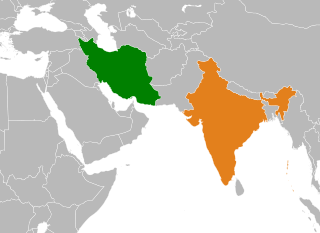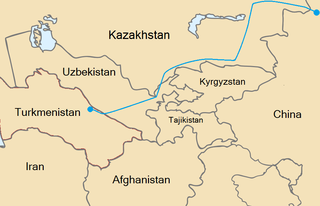| Afghanistan Oil Pipeline | |
|---|---|
| Location | |
| Country | Turkmenistan, Afghanistan, Pakistan, India |
| From | Türkmenabat |
| Passes through | Afghanistan |
| To | India's various northern states |
| Runs alongside | Trans-Afghanistan Gas Pipeline |
| General information | |
| Owner | Unocal Corporation |
| Technical information | |
| Length | 1,813 km (1,127 mi) |
| Maximum discharge | 1 million barrels per day (~5.0×107 t/a) |
The Afghanistan Oil Pipeline was a project proposed by several oil companies to transport oil from Turkmenistan and Central Asia through Afghanistan to Pakistan and India.
In the 1990s, the American Unocal Corporation considered building a 1,800-kilometre-long (1,100 mi)1,000,000 barrels per day (~5.0×107 t/a) oil pipeline to link Turkmenistan's Türkmenabat (former Chardzou) to India along the Arabian Sea, providing a possible alternative export route to the Omsk (Russia) – Pavlodar (Kasakhstan) – Shymkent – Türkmenabat Pipeline. The pipeline was expected to cost US$2.5 billion. However, due to political and security instability at that time, the project was put on hold. But, the plan was later revived after the United States-led invasion of Afghanistan in 2001. [1]
Some have proposed that the actual motive for the United States-led Western invasion of Afghanistan in 2001 was Afghanistan's importance as a conduit for oil pipelines to Afghanistan's neighbouring countries, by effectively bypassing Russian and Iranian territories, and breaking the Russian and Iranian collective monopoly on regional energy supplies. [2] Others have argued that the theoretical pipeline was not a significant reason for the invasion because most Western governments and their respective oil companies preferred an export route that went through the Caspian Sea to Azerbaijan then to Georgia and on to the Black Sea instead of one that goes through Afghanistan. [3]
In 2018, Afghanistan broke ground on the 1,127-mile-long Afghanistan oil pipeline that will connect the state of Punjab in northern India with the Galkynysh gas field in the desert in eastern Turkmenistan. Once energy starts to flow, the country of Afghanistan expects about $400 million a year in transit fees, partly offsetting some of the international aid that now props up the government. [1]
The United States is backing the pipeline, which will carry 33 billion cubic meters of gas per year, passing through five southern Afghan provinces — Herat, Farah, Nimruz, Helmand and Kandahar — that have been Taliban strongholds, and a major security concern. However, both the Taliban and Pakistan, a country believed to hold sway over the insurgent group, have pledged support. [1]
At an estimated cost of US$10 billion, [4] an Isle of Man-based holding company will oversee the project with Turkmengaz, a Turkmenistan state company. Turkmenistan officials have also said that they have received loans from Saudi Arabia’s Islamic Development Bank. The pipeline is expected to be completed by 2020. [1]

The economy of Turkmenistan is one of the fastest-growing economies in the world. Turkmenistan is largely a desert country with intensive agriculture in irrigated areas, and huge gas and oil resources. In terms of natural gas reserves, it is ranked 6th in the world. Turkmenistan’s two largest agricultural crops are cotton, most of which is produced for export, and wheat, which is domestically consumed. Turkmenistan is among the top ten producers of cotton in the world.
Transport in Turkmenistan includes such as roadways, railways, airways, seaways, waterways, oil, gas and water pipelines.

Turkmenistan, also known as Turkmenia, is a sovereign country in Central Asia, bordered by Kazakhstan to the northwest, Uzbekistan to the north and east, Afghanistan to the southeast, Iran to the south and southwest and the Caspian Sea to the west. Ashgabat is the capital and largest city of the country. The population of the country is 6 million, the lowest of the Central Asian republics. Turkmenistan is one of the most sparsely populated nations in Asia. Citizens of Turkmenistan are known as Turkmenistanis, Turkmenians or Turkmens.
The Turkmenistan–Afghanistan–Pakistan–India Pipeline (TAPI), also known as Trans-Afghanistan Pipeline, is a natural gas pipeline being developed by the Galkynysh – TAPI Pipeline Company Limited with participation of the Asian Development Bank. The pipeline will transport natural gas from the Galkynysh Gas Field in Turkmenistan through Afghanistan into Pakistan and then to India. Construction on the project started in Turkmenistan on 13 December 2015, work on the Afghan section began in February 2018, and work on the Pakistani section was planned to commence in December 2018. The abbreviation TAPI comes from the first letters of those countries. Proponents of the project see it as a modern continuation of the Silk Road.

Petroleum politics have been an increasingly important aspect of diplomacy since the rise of the petroleum industry in the Middle East in the early 20th century. As competition continues for a vital resource, the strategic calculations of major and minor countries alike place prominent emphasis on the pumping, refining, transport, sale and use of petroleum products. However, international climate policy and unconventional oil and gas developments may change the balance of power between petroleum exporting and importing countries with major negative implications expected for the exporting states.

Central Asia has long been a geostrategic location because of its proximity to the interests of several great powers and regional powers.
Sources include: Dow Jones (DJ), New York Times (NYT), Wall Street Journal (WSJ), and the Washington Post (WP).

India–Iran relations, also knows as Indian-Iranian relations or Indo-Iranian relations, refers to the bilateral relations between India and Iran. Independent India and Iran established diplomatic relations on 15 March 1950. During much of the Cold War period, relations between the Republic of India and the erstwhile Imperial State of Iran suffered due to their different political interests—non-aligned India fostered strong military links with the Soviet Union, while Iran enjoyed close ties with the United States. Following the 1979 revolution, relations between Iran and India strengthened momentarily. However, Iran's continued support for Pakistan and India's close relations with Iraq during the Iran–Iraq War impeded further development of Indo–Iranian ties. In the 1990s, India and Iran supported the Northern Alliance in Afghanistan against the Taliban regime. They continue to collaborate in supporting the broad-based anti-Taliban government led by Ashraf Ghani and backed by the United States. The two countries signed a defence cooperation agreement in December 2002.
The Iran–Pakistan gas pipeline, also known as the Peace pipeline, or IP Gas, is an under-construction 2,775-kilometre (1,724 mi) pipeline to deliver natural gas from Iran to Pakistan.

The Trans-Caspian Gas Pipeline is a proposed subsea pipeline between Türkmenbaşy in Turkmenistan, and Baku in Azerbaijan. According to some proposals it will also include a connection between the Tengiz Field in Kazakhstan, and Türkmenbaşy. The Trans-Caspian Gas Pipeline project is purposed to transport natural gas from Turkmenistan and Kazakhstan to European Union member countries, circumventing both Russia and Iran. It is also considered as a natural eastward extension of Southern Gas Corridor. This project attracts significant interest since it will connect vast Turkmen gas resources to major consumer geographies as Turkey and Europe.

Iran–Pakistan relations covers the bilateral relations between the adjacent states of Iran and Pakistan. After Pakistan gained its independence in August 1947, Iran was one of the first countries to recognize its sovereign status. Relations between Shi'a-majority Iran and Sunni-majority Pakistan became greatly strained due to sectarian tensions in the 1980s, as Pakistani Shi'a Muslims claimed that they were being discriminated against under the Sunni-biased Islamization program being imposed throughout Pakistan by the military dictatorship government of then-President, General Muhammad Zia-ul-Haq. Following the 1979 Islamic Revolution, Iran and Saudi Arabia gradually began to use Pakistan as a battleground for their proxy sectarian conflict, and Pakistan's support for the Deobandi Taliban organization in Afghanistan during the civil wars in the 1990s became a problem for Shi'a Iran, which opposed a Taliban-controlled Afghanistan.

The Central Asia–China gas pipeline is a natural gas pipeline system from Central Asia to Xinjiang in the People's Republic of China. By connecting Turkmenistan to China’s domestic grid, this pipeline makes it possible to transport gas some 7000 km from Turkmenistan to Shanghai. More than half of Turkmen natural gas exports are delivered to China through the pipeline.

Kazakhstan owns large reserves of energy resources, and therefore the energy policy of Kazakhstan has influence over the world's overall energy supply. Although Kazakhstan has not described itself as an energy superpower, Kazakhstan's former president Nursultan Nazarbayev has claimed Kazakhstan will become a factor of energy security in Asia and Europe. Kazakhstan has a strategic geographical location to control oil and gas flows from Central Asia to East (China) and West.

Chabahar Port is a seaport in Chabahar located in southeastern Iran, on the Gulf of Oman. It serves as Iran's only oceanic port, and consists of two separate ports named Shahid Kalantari and Shahid Beheshti, each of which has five berths.
The Oil Factor, alternatively known as Behind the War on Terror, is a 2004 movie written and directed by Gerard Ungerman and Audrey Brohy, narrated by Ed Asner. The documentary analyzes the development of some global events since the beginning of the century from the perspective of oil and oil-abundant regions.
The Neka–Jask pipeline is a proposed oil pipeline in Iran. If constructed, it will transport crude oil from Kazakhstan, Azerbaijan, Turkmenistan and Russia through the port of Neka on the Caspian Sea to Jask, Iran on the Gulf of Oman. The planned capacity of the 1,515 kilometres (941 mi) pipeline is 1 million barrels per day of crude oil. It is expected to cost US$2 billion.

India–Kazakhstan relations, also referred to as Indian-Kazakhstani relations or Indo-Kazakhstani relations, are the bilateral relations between India and Kazakhstan. Diplomatic relations have increased in significance in the 21st century after initially remaining passive in the 1990s. Both nations seek to develop an extensive commercial and strategic partnership in the Central Asia region.

Energy in Afghanistan is provided by hydropower followed by fossil fuel and solar power. According to Da Afghanistan Breshna Sherkat (DABS), approximately 35% of Afghanistan's population has access to electricity. This covers the major cities in the country. Many rural areas do not have access to 24-hour electricity but this should change after the major CASA-1000 project is completed.

For the economic effects refer to Economy of Iran.